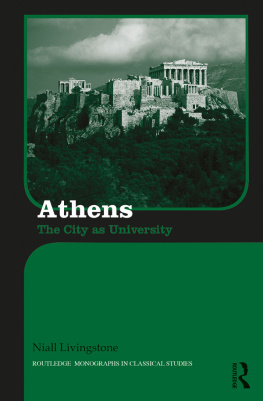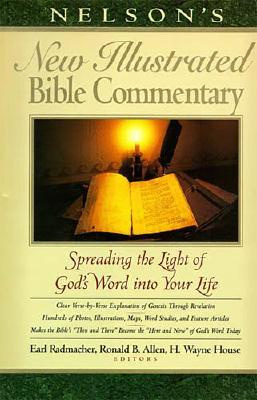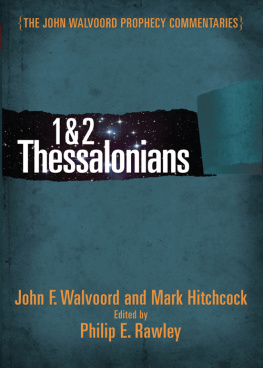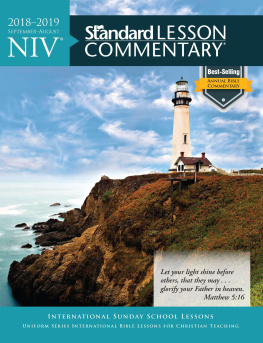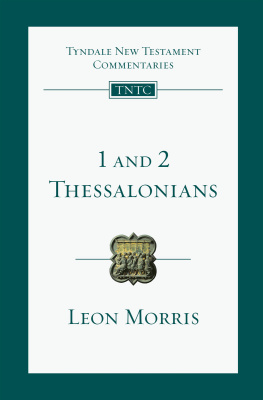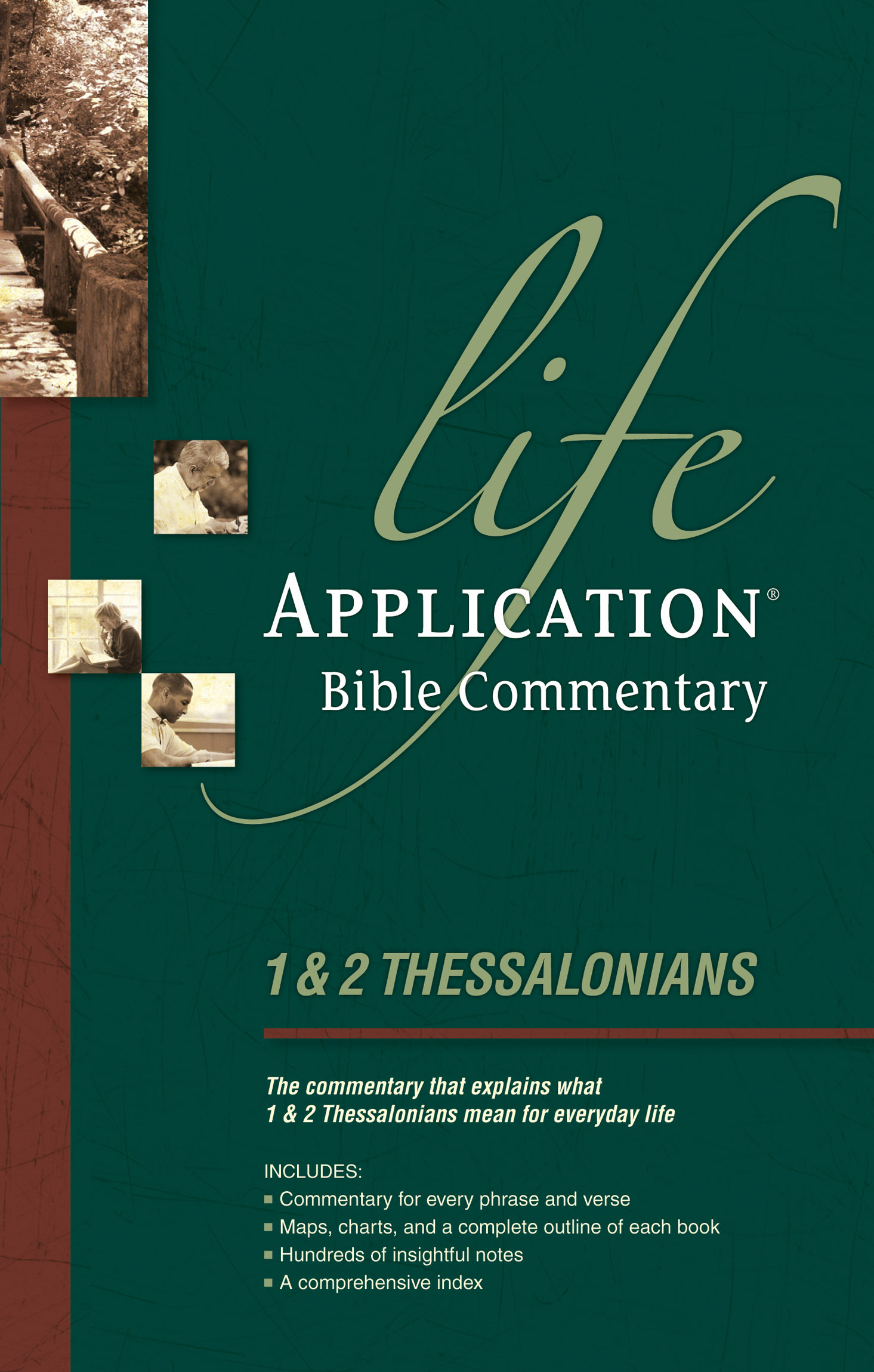Visit Tyndale online at www.newlivingtranslation.com and www.tyndale.com.
Life Application Bible Commentary: 1 & 2 Thessalonians
Copyright 1999 by The Livingstone Corporation. All rights reserved.
Contributing Editors: James C. Galvin, Ed.D., and Ronald A. Beers
Cover photograph of bridge and path copyright by Alyn Stafford / iStockphoto. All rights reserved.
Cover photographs of woman with a laptop and man holding a pen copyright by Dan Wilton / iStockphoto. All rights reserved.
Cover photo of man reading copyright by Ronnie Comeau / iStockphoto. All rights reserved.
Interior illustrations of sun (1 Thessalonians) and spider (2 Thessalonians) copyright 2004 by Tracy Walker. All rights reserved.
Scripture taken from the Holy Bible, New International Version, NIV. Copyright 1973, 1978, 1984 by Biblica, Inc. Used by permission. All rights reserved worldwide.
Scripture quotations marked NKJV are taken from the New King James Version. Copyright 1979, 1980, 1982 by Thomas Nelson, Inc. Used by permission. All rights reserved.
Scripture quotations marked NRSV are taken from the New Revised Standard Version of the Bible, copyright 1989, Division of Christian Education of the National Council of the Churches of Christ in the United States of America. Used by permission. All rights reserved.
(No citation is given for Scripture text that is exactly the same wording in all three versionsNIV, NKJV, and NRSV.)
Scripture quotations marked KJV are taken from the Holy Bible, King James Version.
Scripture quotations marked NLT are taken from the Holy Bible, New Living Translation, copyright 1996 by Tyndale House Foundation. Used by permission of Tyndale House Publishers, Inc., Carol Stream, Illinois 60188. All rights reserved.
TYNDALE, Life Application, New Living Translation, NLT, and Tyndales quill logo are registered trademarks of Tyndale House Publishers, Inc.
Library of Congress Cataloging-in-Publication Data
Barton, Bruce B.
1 & 2 Thessalonians: life application commentary / Bruce B. Barton, Linda
Taylor, Dave Veerman; general editor, Grant Osborne.
p. cm.(Life application Bible commentary)
Includes bibliographical references ( p. ) and index.
ISBN 978-0-8423-2862-3 (sc : alk. paper)
1. Bible. N.T. ThessaloniansCommentaries. I. Taylor, Linda Chaffee, date.
II. Veerman, David. III. Osborne, Grant R. IV. Title. V. Title: 1 and 2 Thessalonians. VI. Series.
BS2725.3.B37 1999
227.81077dc2198-45169
Build: 2020-10-01 08:55:04 EPUB 3.0
FOREWORD
The Life Application Bible Commentary series provides verse-by-verse explanation, background, and application for every verse in the New Testament. In addition, it gives personal help, teaching notes, and sermon ideas that will address needs, answer questions, and provide insight for applying the Word of God to life today. The content is highlighted so that particular verses and phrases are easy to find.
Each volume contains three sections: introduction, commentary, and reference. The introduction includes an overview of the book, the books historical context, a time line, cultural background information, major themes, an overview map, and an explanation about the author and audience.
The commentary section includes running commentary on the Bible text with reference to several modern versions, especially the New International Version, the New Revised Standard Version, and the New Living Translation, accompanied by life applications interspersed throughout. Additional elements include charts, diagrams, maps, and illustrations. There are also insightful quotes from church leaders and theologians such as John Calvin, Martin Luther, John Wesley, and A. W. Tozer. These features are designed to help you quickly grasp the biblical information and be prepared to communicate it to others. The reference section includes an index and a bibliography.
INTRODUCTION TO 1 THESSALONIANS
You wont learn unless you ask questions! Countless teachers and parents have explained that truth to children as they begin their educational experience. Those who desire to train others and impart knowledge dont mind responding to queries. Questions help them know what students are thinking and learning. Those who dont verbalize their doubts, voice their concerns, or seek to clarify what they have heard often harbor misunderstanding, go the wrong way, or live in ignorance.
Paul, master teacher, also felt like a father to believers in the churches he had planted on his missionary journeys. In both roles, he eagerly welcomed students questions and patiently responded. With limited time in each location, however, Paul could not cover every topic, resolve every conflict, or answer every question, so he wrote letters to his beloved churches. Each letter had a purpose and spoke to specific needs.
Paul wrote this epistle, his first to the church at Thessalonica, to answer believers questions and to commend them on their faith and commitment to Christ. The Thessalonians had questions... and they asked them. As you read this short, personal letter, look for answers for yourself. Also, think of questions that you will ask your spiritual mentor... and then learn.
AUTHOR
Paul (Saul of Tarsus): apostle of Christ, missionary, church planter, and gifted teacher.
The first verse of this letter identifies Paul as the author. Pauls traveling companionsSilas and Timothyare mentioned as well, but Paul is clearly the primary author because the pronoun I is used so often: When I could bear it no longer, I sent Timothy (3:5 NLT ).
As he had done on other occasions (see 1 Corinthians 16:21; Galatians 6:11; Colossians 4:18), Paul most likely dictated this letter to a scribe. Timothy, Pauls trusted assistant, may have been the one who actually transcribed the words. Also, Silas, who assisted Paul in founding the Thessalonian church, would have been very interested in this letter and may have offered suggestions on what to say.
At the end of this letter, however, Paul took ultimate responsibility for the contents when he again used the pronoun I in his final statement: I command you in the name of the Lord to read this letter to all the brothers and sisters (5:27 NLT ).
Although critical scholars have challenged Paul as the author of most of the New Testament letters that bear his name, his authorship of 1 Thessalonians has been largely unchallenged (see the introduction for 2 Thessalonians). A few have suggested that Silas may have been the primary author of this letter because it does not reflect Pauls emphasis on law and grace (see Romans 5:1-21; 2 Corinthians 8:9; Galatians 3:18; 5:4). Instead, 1 Thessalonians focuses on the return of Christ (4:135:11). It may be true that Silas influenced the contents of this epistle, but he is not the primary author. Paul explicitly names himself as the authority behind this epistle (cf. 2:18 with 5:27). Early Christian writers, such as Irenaeus, Origen, and Eusebius, identified 1 Thessalonians as one of Pauls letters.
Pauls story. Ever since his dramatic conversion on the road to Damascus, Paul had been totally committed to Jesus and had taken every opportunity to proclaim him as the Messiah (Acts 9). In that blinding vision, Jesus called Paul to be a missionary evangelist. Before his conversion, Pauls goal had been to persecute Christians; since that life-changing moment, however, he focused on spreading the truth, the good news, about Jesus. During the next couple of decades, Paul traveled most of the Roman world, preaching to whomever would listen and establishing churches in the cities he visited. His message, however, was not always accepted. Jews opposed him in Damascus, Jerusalem, and just about every city and town he visited on his journeys, including Thessalonica.


